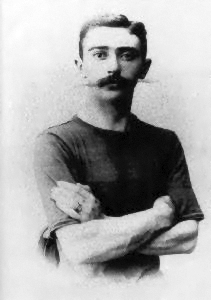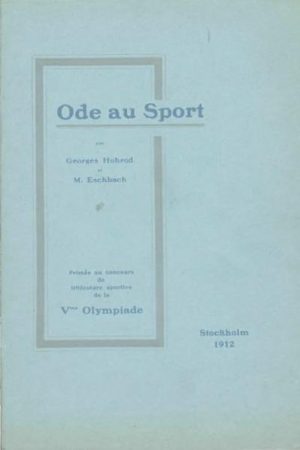Kurt Kohlstedt: Pentathlon of the Muses
The Olympic Games can seem almost timeless, going back to ancient Greece; it can be easy to forget how recently the modern version of Games as we know them today were launched, just over a century ago. And for decades, a series of now largely forgotten arts competitions (featuring medals and everything) were a huge part of the Games.
 The inclusion of the arts can be traced back to the same person broadly credited with launching the modern Olympics: Pierre de Coubertin. He was a French aristocrat who advocated for and ultimately organized the International Olympic Committee, which is still around today.
The inclusion of the arts can be traced back to the same person broadly credited with launching the modern Olympics: Pierre de Coubertin. He was a French aristocrat who advocated for and ultimately organized the International Olympic Committee, which is still around today.
The first modern international Olympic Games were hosted in 1896. Athens was chosen as the first host city, an explicit nod to the Ancient Greek Olympics. At first, they were the Games as we know them today, featuring sports like swimming and fencing. But after a few successful events, Coubertin sprung the idea to add arts categories.
 In 1906, the IOC unveiled five artistic categories: architecture, literature, music, painting and sculpture. And the artists participating in this new “Pentathlon of the Muses” were supposed to be amateurs, much like their counterparts in sports. There was some limited precedent for this addition — ancient Olympic competitions for music, singing, even heralding. Coubertin argued that “In the high times of Olympia, the fine arts were combined harmoniously with the Olympic Games to create their glory. This is to become reality once again.” But there was a caveat: the artistic entries were still supposed to be related to sports.
In 1906, the IOC unveiled five artistic categories: architecture, literature, music, painting and sculpture. And the artists participating in this new “Pentathlon of the Muses” were supposed to be amateurs, much like their counterparts in sports. There was some limited precedent for this addition — ancient Olympic competitions for music, singing, even heralding. Coubertin argued that “In the high times of Olympia, the fine arts were combined harmoniously with the Olympic Games to create their glory. This is to become reality once again.” But there was a caveat: the artistic entries were still supposed to be related to sports.
 In the realm of architecture, for example, contenders submitted things like athletic stadiums, sporting complexes, playing fields, swimming pools, even ski jumps. Some of these were first ‘published’ during the Olympics, while others were actually built structures already out in the world. When buildings weren’t close by, renderings or photos were used to judge them. But in some cases, the structures were close at hand: In the 1928 Games in Amsterdam, a Dutch architect won the gold medal for the stadium being used in those Olympics. By that time, the arts Olympics were in full swing, with over 1,000 entries that year.
In the realm of architecture, for example, contenders submitted things like athletic stadiums, sporting complexes, playing fields, swimming pools, even ski jumps. Some of these were first ‘published’ during the Olympics, while others were actually built structures already out in the world. When buildings weren’t close by, renderings or photos were used to judge them. But in some cases, the structures were close at hand: In the 1928 Games in Amsterdam, a Dutch architect won the gold medal for the stadium being used in those Olympics. By that time, the arts Olympics were in full swing, with over 1,000 entries that year.

For a while, the arts continued to grow in popularity. It got to the point where the IOC added new subcategories in the arts, like orchestra, dramatic works, even town planning. But as these creative competitions grew popular, they naturally started to draw in more aspiring professionals and veteran creatives. And some participating artists were even selling their works during the Games. Meanwhile, the IOC was really pushing this idea of absolute amateurism in the 1940s, and things like a working sports stadium winning the gold didn’t quite fit this vision for the competitions.
There were other problems, too, like artists not wanting to participate, potentially lose, and thus damage their reputation. Plus the ‘sports’ focus for arts was pretty limiting. Eventually, after the London Games in ‘48, the IOC discontinued the arts competitions altogether. Now there’s a separate Cultural Olympiad, but medals are just for sports.
 Perhaps the strangest arts winner was Coubertin himself, who won a gold medal in an arts category in the 1912 Paris Olympics. He got his award for literature, more specifically: poetry, for a piece titled Ode to Sport. Now, there’s a good argument to be made that he was simply trying to spur more competitors at the launch of this new category, but perhaps he had a secondary motive. If he wasn’t a good match for the sports side side, maybe the arts represented his one shot at the gold.
Perhaps the strangest arts winner was Coubertin himself, who won a gold medal in an arts category in the 1912 Paris Olympics. He got his award for literature, more specifically: poetry, for a piece titled Ode to Sport. Now, there’s a good argument to be made that he was simply trying to spur more competitors at the launch of this new category, but perhaps he had a secondary motive. If he wasn’t a good match for the sports side side, maybe the arts represented his one shot at the gold.



Comments (4)
Share
On the topic of Michael Phelps & sculpting, he has (or certainly had) sculpted his body to a degree that many would find very easy on the eye, for a given definition of ‘sculpt’ of course.
And on the topic of the NBA logo, I would think that democracy and some ground rules are the answer here.
a. The basic format of the logo stays the same, only the silhouette would vary.
b. Allow submissions of silhouettes from current players within the association.
c. The players upon whom the silhouettes are based must be dead.
d. Only the current players within the Association may vote.
e. They may vote for, say, 5 silhouettes in order of their choice and the single transferable vote is used.
f. The silhouette that eventually reaches the quota is chosen. If the quota is not reached and there are no more transferable votes, the silhouette with the highest rank is chosen. In the event of a tie, a coin is tossed.
g. The logo is changed once a decade on the same date (or xth weekend of a month).
Here we let the players choose and one of the great players of the past will be honoured. It is democratic and those who disagree will have to live with it.
Regarding the NBA logo, why don’t they use an image of a basketball entering the net? Do away with the player totally.
On the topic of the NBA Logo, why not just have the logo for the year be a silhouette of the previous year’s MVP? This way the logo would remain current and even provide a new, interesting revenue stream for the NBA.
In this episode, Mary Roach paints Canada Geese and their abundant feces as a harmless nuisance. This is false and a bit shocking to hear being asserted on this podcast without being fact checked. There are a number of associated pathogens in avian waste that can enter the water, soil, and air. This is permanently etched in my mind as construction at my medical school aerosolized particles of Great Egret droppings from a rookery on campus, resulting in several people becoming severely ill with pulmonary histoplasmosis. One person required a pulmonary lobectomy as a result.
There are several peer-reviewed articles written on the pathogens associated with Canada Geese in specific. The CDC has a more layman-oriented document on this: https://www.cdc.gov/niosh/docs/2005-109/pdfs/2005-109.pdf